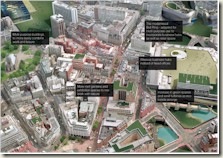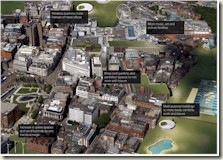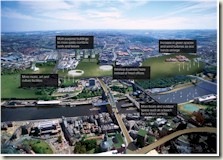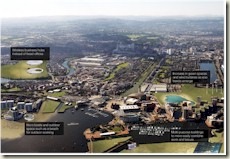Futurelabs Report - Work and Mobile Cities
THE FUTURE LABORATORY
MICROSOFT
Work and Mobile Cities


Brighton before Brighton after


Birmingham before Birmingham after


Edinburgh before Edinburgh after


Manchester before Manchester after


Newcastle before Newcastle after


Plymouth before Plymouth after
Strategy and Insight Directors : Martin Raymond, Chris Sanderson, Tom Savigar, Timo Veikkola
Creative Director : Kate Franklin
Head of Trends, Editorial : Gwyneth Holland
Head of Trends, Visual : Caroline Till
Senior trends analyst : Vicky Langdon
Trends analysts : Jasmine Labeau, Jacob Strand
Trends researchers : George Collings, Max Reyner, Ravi Khanna
Picture editor : Sophie Ekwe-Bell
Copy editor : M. Astella Saw
Design manager : Jodie Newman
Designers : Hannah Baxter
LifeSigns Network editor : Miriam Rayman
LifeSigns Network manager : Martin Farrington
Studio manager : Andrew Graham
Finance manager : Sian Welsh
Finance assistant : Andy Stewart
Sales and new business manager : Hester Chan
Production : Emma Baines
Studio intern : Alison Welldon
The Future Laboratory : Studio 2,
181 Cannon Street
Road,
London E1 2LX, United Kingdom
Phone +44 20 7791 2020 Fax +44 20 7791 2021
Email office@thefuturelaboratory.com
thefuturelaboratory.com
The Future Laboratory is one of Europe’s leading trend, brand and futures consultancies.
With its 3,000-strong global LifeSigns Network, it connects over 250 clients with all aspects of culture set to impact on consumer change. The Future Laboratory publishes quarterly insight reports on retail, technology, design, luxury, interiors and leisure. For further information contact: sales@thefuturelaboratory.com
lifesignsnetwork.net
This document has been produced as an internal research document and is not intended for public distribution or use. Every effort has bee n ma de to ensure accuracy of copy and to secure approval and accreditation n for all images used. © 2008
Introduction : 04
Quant overview : 08
Typologies : 11
Conclusion : 14
Introduction
We may not yet have reached the futurism of Minority Report or I, Robot-style workplaces, but a study into remote working in Britain has uncovered some surprising results.
The Future Laboratory’s survey and report on mobile technologies and flexible working across UK offices shows that the working map of Britain is being redrawn, with increasing numbers of people working in knowledge-based professions and hubs that allow greater flexibility of working schedules and locations.
The key change we are witnessing depicts a shift from traditional fixed location workplaces to a ‘mosaic pattern of working’, says Professor Alan Felstead, author of Changing Places of Work and research professor at the Cardiff School of Social Sciences at Cardiff University. ‘There’s not a week that goes by without an article suggesting that we’re all working from home.
There is a change, but it’s of a gradual nature,’ he says. ‘True, people are spending more time working from home, but we’re also working in a variety of locations more and more than in any single place.’
In a survey commissioned by The Future Laboratory on behalf of Microsoft, the majority (70%) of UK office workers say that work in the 21st century is increasingly about a work/life balance and working flexible hours as required. We call this group our Flexi-bods; they, like our 9-to-5ers, Firefighters and Combi Heads, embrace the social and business advantages that mobile technology has to offer. A further 79% of the survey participants tell us that remote working is more convenient than office-based working, while a huge 20% of British office workers tell us they spend one day per week working away from the office. A whopping 13% spend four or more days away from the office.
Flexi Britain
The UK is one of Europe’s leading providers of flexible working capability, with 22% of UK businesses making it possible for their employees to work flexibly1. It is estimated that more than 57% of UK employees now work flexible hours and locations through job-sharing and part-time homeworking2. The Carnegie UK Trust, a global not-for-profit foundation supporting democracy, peace and sustainability, believes this phenomenon is a major driver of civic change, reconnecting individuals with their local communities. In fact, one study goes so far as to suggest that new mobile technologies are benefiting the national economy by £9bn a year3 as more people work while commuting.
‘We found that people are not conscious of where and when they are working,’ Professor Felstead says. ‘My feeling is that work is becoming more fragmented in the times and spaces where it’s done. Most surveys ask people where they mainly work, which doesn’t take into account the half-hour on the train they spend on a work phone call or reading a document.’
Government figures show that 3.06m people work from home, a number equivalent to 12% of the UK workforce, with more and more companies such as BT actively encouraging home working amongst their staff. One study by The Work Foundation revealed that almost 50% of business services organisations offer tele- or home working, while nearly 80% offer flexible working4. Meanwhile, research from office management company Jones Lang LaSalle found that workers are at their desks, on average, for less than 40% of their time5.
The knowledge economy
All of these shifts in working policy could largely be due to the increase in the number of those working in knowledge-based and creative professions. Financial and business services now account for one in five UK jobs, compared with one in 10 back in 1981, according to the Office for National Statistics. Another shift has seen an increase in self-employment, with an estimated 3m Brits working for themselves in 20016. Finance, media, publishing and business sectors showing the highest figures of self-employment and short-term working. Similarly, The Work Foundation estimates that a record 1,000 small businesses are being created every day7. In 2005, the knowledge economy was worth an estimated £76m, accounting for 70% of all service exports8.
High-tech turn-on
With greater numbers of Brits working in professions that allow them the flexibility of time and location (as opposed to the fixed work days and locations of the manufacturing industry, for instance), and the growth of always-on culture and wireless technologies, we can expect to see more people choosing to work remotely from home; in ‘third spaces’ such as trains, hotels and parks; in collaborative hubs; and using cloud computing, software that runs from the internet rather than individual computers.
In 2007, nearly 61% of households in the UK (15m people) had internet access9, an increase of 36% since 2002; by June 2008 there were 13m broadband connections10. We exist in an increasingly mobile society, with 80% of the world’s population living within a mobile network. Faster internet connections, ubiquitous broadband and the advent of all-in-one devices are driving social change like never before. Our survey found that 66% of all respondents say mobile technologies allow them to determine their own schedules. In addition, 18% tell us that head offices will be redundant in the future, with the majority of employees instead working from home laptops and localised business hubs.
Even 3G mobile broadband, still relatively new to the UK, is regularly being used by 11% of our survey participants to remotely conduct their business. ‘Mobile internet has every indicator in terms of an early-stage technology,’ says Tim Johnson, chief analyst at Point Topic (point-topic. com), the leading broadband analysis website. ‘One of the things with early technologies is that they have various false starts, and mobile technology has had various false starts with this. Do you remember WAP? With 3G mobile, the technology has leapt forward a lot.’
Location, location
As you’ll see in the Tropics of Creativity section, the working map of the UK is being redrawn.
The centres of the last industrial age, such as Manchester, Leeds, Newcastle and Liverpool, are forming new identities upon their industrial heritage, rewriting their future in such sectors as multimedia and information and communications technology (ICT).
Our research also reveals the emergence of new creative and technology-driven hubs in cities such as Plymouth in Devon. Plymouth may only be the 15th most populous city in Britain and home to just 250,000 people, but we’ve renamed it the Wired Underground, such is its uptake of elements of connectivity such as broadband and 3G mobile. The city also has the highest figures of all those in our survey working from home offices (12% higher than the national average), and those working four or more days a week out of the office (a huge 20% above the average).
Work/life balance
In addition to the prevalence of leading ICT in the South West region, our experts put Plymouth’s wired-up flexibility down to the city’s work/life attitude. Our 16-24-year-old office workers support this position, telling us that they prefer an existence with a strict division of work and home life, and that they prefer to keep the working week to a minimum of hours. Similarly, in a US survey by marketing consultancy Yankelovich, 65% of 24-35-year-olds say they prefer to look for ‘a job in the place that [they] would like to live in’ rather than ‘the best job [they] can find, location secondary’11.
This goes some way towards helping us paint a picture of the working map of the future, as this lifestyle-focused, teched-up and fully flexible working population comes of age. In fact, 18% of our survey participants tell us that in the next 25 years, we will conduct the majority of our work from home laptops, only meeting with colleagues and clients when we have to. Meanwhile, the majority of 16-24-year-olds (23%) and 24-34-year-olds (21%) believe that as technology becomes more collaborative, we will begin to work from localised business hubs rather than head offices.
Is the office dead?
However, our findings also confirm that the office as we know it is far from dead in the water. When asked what effect technological changes would have on the way we work and live over the next 25 years, the majority (20%) of our survey respondents tell us that despite the increased flexibility afforded by new technologies, employees will always want offices to go to. This is further confirmed by the 50% of British office workers who tell us that the main issue preventing them from working remotely on a more regular basis was that they prefer to work in an office, where they can access all of their work needs conveniently. ‘I think there’s always going to be a limit to the extent to which mobile and homeworking will happen,’ Prof Felstead says. ‘We are social beings, so the idea that we’re always going to talk on phones and webcams is unlikely. We’re still going to need the human interaction. We might not meet in the office necessarily, but we still have to meet.’
Notes :
01 : ‘Flexible Working in Europe and Russia ’,Avaya , 2008
02 : ‘ The Future of Civil Society ’, The Carnegie UK Trust
03 : ‘Britain on the Move’, CBS Out door
04 : ‘Workplace Trends 2003–2006’, The Work Foundation
05 : ‘ The New Oases ’, The Economist , 12 April 2008
06 : ‘ The Jobs People Do ’, Office for National Statistics
07 : ‘Work UK’, The Work Foundation
08 : ‘environmental scanning: trends affecting the world of work in 2018’, Chartered management institute, March 2008
09 : ‘Internet Access ’, Office for National Statistics
10 : ‘ Towns triumph in broadband tests ’, BBC News,3 June 2008
11 : ‘What Do Young Jobseekers Want ? ’, The Ne w York Times, 6 September 2007
Quant Overview
Offices in modern-day Britain have undergone seismic shifts in notions of working. While we may not have seen the complete revolution that many futurologists predicted years ago – bringing the complete death of the office, wall-to-wall hot-desking, and the paperless and people-less workplace – the average working Brit is embracing mobile technology and flexible working like never before.
There are still issues to be addressed from both a social and technical perspective, but the majority of UK office-goers are seeing their working routines positively altered, to differing degrees, by the advances of mobile technology.
Office shift
Large numbers of Brits are embracing the flexible working possibilities that mobile technologies have to offer. In our survey of office workers across key British cities, a huge 20% tell us they are now able to work away from the office one day every week thanks to mobile technology. A further 13% say they can now spend four or more days working out of the office.
Goodbye, 9-to-5
This flexibility doesn’t necessarily mean we are working less, however. Despite 35% of our survey participants telling us they feel that managers don’t trust them to work independently, and a further 33% worrying that their colleagues will believe they’re slacking if they work out of the office, our statistics show that this is far from the case. Among our survey respondents, 23% spend more time working in the evening or at night, 15% at weekends, and 9% before they go to the office.
Increased access to mobile technologies is supposed to make our lives easier, but the majority of UK office workers believe we will see an increase in the length of the average working week, from the current 42.7 hours to 45 hours.
Go where the work takes you
In our survey, nearly half of all office workers (44%) tell us they are increasingly working from their home offices. However, there is also an ‘anytime, anywhere’ attitude that we are embracing wholeheartedly. British office workers are using mobile technologies to allow them to work from diverse locations: 8% tell us they are working more at hotels; 7% on trains and at stations; a sorry 5% on holiday; 4% at wifi cafés; 4% in their cars; 3% at the airport; and 2% outdoors, in parks, precincts and shopping malls.
Remote advantages
It is unsurprising, therefore, that the majority (79%) of our survey respondents cite convenience as the biggest advantage of remote working. This flexible attitude sees a further 66% saying that mobile technologies allow them to determine their own schedules. Despite the long working hours that remote working can bring, 63% tell us it contributes to their work/life balance. Interestingly, 16% of British office workers say that remote working allows them to be more creative, and 6% say it increases their contact with clients.
Tool time
Of all the mobile working tools that are driving this remote business revolution, email (67%), mobiles (41%), and wireless laptops (36%) are being used more than ever, report our office workers.
Meanwhile, instant messaging (IM) is being increasingly used by 15% of our respondents and 3G mobile broadband by 11% (outstripping BlackBerry and PDA use by 1%). Only 3% of our respondents are using business-related podcasts, and 2% Twitter and blogs.
The big issues
It’s not all plain sailing when it comes to our use of mobile technologies and remote working, however. We have already seen that large numbers of UK office workers feel discouraged from working remotely because of perceived attitudes of managers and colleagues. When asked why else they do not work remotely on a more regular basis, a huge 50% say they prefer to work in their office because they can access their work needs conveniently. Of those who do take their work out of the office, a great deal are discouraged by the difficulties of connection: slow broadband speeds hinder 32% of people; hard to-negotiate company firewalls prevent 28%; and prohibitively high hotspot charges stop a huge 18% from working remotely. One study by the analysis company Gartner found that 75% of UK and US businesspeople are put off using public hotspots because of high charges1.
Fast forward
All of these issues could explain why the majority (20%) of our respondents tell us that, despite technology’s increased flexibility, employees in the future will always want offices to go to. However, that still leaves 80% of British office workers who see a change on the horizon. Of those looking towards a more mobile future, 18% tell us they believe we will do most of our work from our home laptops, meeting with colleagues and clients only when we have to, and a further 12% tell us they believe that being able to work from home and while travelling will mean that offices will become as extinct as UK factories and heavy manufacturing plants.
Tomorrow’s office
While the office of the future will still have a place in working Britain, our survey participants see
its role being greatly altered over the next 10 to 25 years. Among our respondents, 18% believe that, as technology becomes more collaborative, we will no longer have to go to the head office, instead working from localised business hubs. Another 17% say that work in the future will be about negotiating flexible timetables, working collaboratively to determine when to work from home and when to come to the office. In this office of the future, the remote working technologies that Brits think will be commonplace in the next 25 years are free and all-pervasive wireless (59%); cloud computing, where all documents are stored remotely and accessed from a remote global server (36%); and intuitive, collaborative and interactive networks (ICONs), in which point-and-drag screen technology allows us to work in a Minority Report style (23%).
Tied-down youth, freedom seniors
When it comes to mobile and remote working, age and experience count for something. A huge 21% of those aged 55 and over tell us they work away from the office four or more days a week; they are also the most likely to fall into our Flexistentialist typology (see Section 3), with a huge 73% telling us they like a flexible work and home balance. Meanwhile, 65% of those 55 and above, and 47% of 45-54-year-olds are working increasingly from their home offices. Those aged 55 and over work the most at hotels (11%) and from airports (5%). When it comes to these switched-on seniors, this group demonstrates a positive outlook towards remote technologies – a whopping 71% of them think that free and all-pervasive wireless will be
commonplace in the future. Meanwhile, 21% of this group (the highest proportion among all the age groups) believe that mobile technologies will, in the future, have us conducting most of our work from home laptops. This could be because they have the most ability of any age group (80%) to access their work server remotely.
In fact, the younger our survey respondents are, the less likely they are to spend much time working away from the office at all. In our survey, a quarter of all 16-24-year-olds tell us they still work mainly from the office, although they are also the most likely to work from unconventional locations such as their cars (5%) and outdoor spaces (4%). Following a more traditional path, however, 16-24-year-olds make up the majority of our 9-to-5er typology, with 29% telling us they believe work should happen within set hours and never overlap with their home life. This probably explains why younger respondents are so optimistic about their working hours, with the majority of 16-24-year-olds (21%, double the national average) believing that working hours will stay at 42.7 hours per week.
When it comes to age, the older generation has the definite jump on our so-called switched-on youth, with its members claiming they’re using more technologies than ever to conduct their business remotely. Those aged 55 and over are the highest remote business users of email (75%), mobiles (46%), wireless laptops (40%), company intranets (30%), 3G mobile broadband (14%), video-conferencing/i-camera technology (9%) and business-related podcasts (4%). This could be because our youth demographic can’t yet afford the kit and caboodle required, or it could be because they simply do not see this kind of technology as business as usual.
In any case, the 16-24-year-olds only come out tops in the use of wireless (23%) and Bluetooth (14%) technologies; 25-34-year-olds lead in using IM (18%), business-related chatrooms/forums (5%) and Twitter/blogs (4%).
As for our middle-aged respondents, these 35-44-year-olds are the most likely to work before they go into the office (11%) and while on holiday (5%). Perhaps this is why they outdo the others in their use of BlackBerrys and PDAs (13%). At the time of life where they often balance children with greater responsibilities at work, it is little surprise that those aged between 35 and 54 are the most likely to fall into our Firefighter typology, telling us they are always fighting to keep up in their work and personal lives.
Notes :
01 : ‘Time to halt the Wi Fi rip-off ’, The Sunday Times, 19 February 2006
Typologies
No matter your age, gender or mindset, mobile and remote working are spreading throughout Britain. In our survey of office workers in key UK cities, we found that increasing numbers of people are embracing the flexibility that mobile technologies have to offer. However, there are distinctions in the ways that we use them.
From our research, we have created four categories of mobile worker based on their attitudes and outlooks to working and emerging technologies: Flexi-bods, 9-to-5ers, Firefighters and Combi Heads.
Flexi-bods
‘I am happy to start work early and to work late on occasion, but, equally, I should be able to start late and/or finish early if personal matters require it.’ Making up the majority (70%) of British office
workers, our Flexi-bods believe that the 21st century is increasingly about striking a work/life
balance, with work and home life being given equal weighting. The large majority of this group (73%) are aged 55 and over. They predominantly live in Brighton (81%), Newcastle (79%), Cardiff (77%) and Edinburgh (76%), and are more likely to be women (72% versus 65% of men). Their most-used mobile technologies are email (71%), mobiles (44%), wireless laptops (38%) and –the wildcard – company intranets (30%). The members of this group are the most likely (68%) to feel that remote working contributes to their work/life balance. The majority of them (67%, the highest proportion among all the typologies) also believe that mobile technologies will make it easier for women to compete in the work environment. They think, unsurprisingly, that work in the future will be about negotiating more flexible timetables (21%).
Firefighters
‘I am always fighting to keep up in my work and personal life.’ Telling us that life has increasingly become about reacting to life and work, 7% of our British office workers see themselves as Firefighters – for them, life is quick, fragmented and ever-changing. As this is a group dominated by 35-54-year-olds, it is likely that this out-of-control feeling comes from their having to juggle work, children and a home life.
Accordingly, they were the most likely of our groups (71%) to say that remote working allows them to determine their own schedule. Firefighters are nearly just as often men as they are women – 7% of men and 8% of women fall into this category – and they predominantly live in Belfast (15%), Southampton (10%), Manchester (11%) and Brighton (11%). Proving their name, our Firefighters commonly battle a host of demands on their time, and experience a fragmented workday: they are the most likely to work before they go to the office (18%, double the national average), in the evening and at night (43%), and in their car (7%).
Their most-used mobile technologies are email (74%), mobiles (37%) and wireless laptops (37%). They also demonstrate the most frequent use of IM among all our typologies, with 17% of them (the largest proportion of all the groups) saying they use this technology. It’s not just time that’s a challenge. Firefighters have more issues than other typologies do with feelings of colleague distrust when they work away from the office (37%), as well as with company firewalls (32%), battery longevity (22%) and software knowledge (20%).
9-to-5ers
‘Work in the 21st century is increasingly about life/work separation.’ Our second largest group, 9-to-5ers are the 20% of office workers who tell us that work should be from nine to five and should never overlap with their home life, just as their home life should never overlap with their job. Perhaps surprisingly, a fair proportion of 16-24-year-olds (29%) are 9-to-5ers, although, as we’ve seen with our switched-on youth, this age group in general has an optimistic outlook when it comes to low working hours, perhaps due to their inexperience of business environments. Predominantly living in Norwich (42%), Belfast (31%), Birmingham (29%) and Liverpool (28%), 9-to-5ers are the most likely (56%) to say they are spending increasingly more time working at their workplace, and the least likely to have remote access to their work server. Among all our survey respondents, 24% of men identify as 9-to-5ers, compared to 18% of women.
However, their traditional outlook to the work/life divide doesn’t preclude our 9-to-5ers from mobile and remote working. Far from it, in fact: among our four groups, the largest proportions of 9-to-5ers appreciate the convenience of remote working (83%), and feel it encourages independence (44%).
The members of this group want to work fixed hours, and they happily embrace the advantages of mobile technology to allow them to do so. Their most-used mobile technologies are email (52%), followed by mobiles (33%) and wireless laptops (28%). A surprising 23% say they are not increasingly using any of the mobile technologies we suggested. The majority of our 9-to-5ers (25%) believe, however, that in the future we will do most of our work from home laptops.
Combi Heads
‘There is little or no distinction between work and play.’ Our biggest embracers of mobile and remote working, Combi Heads, for whom the line between life and work is increasingly blurring, make up 3% of our UK office workers. But that doesn’t mean these people are work drones. They embrace mobile technologies as a part of their everyday lives, with 35% telling us that remote working allows them to be more responsive and proactive, and an above-average 21% saying it makes them more creative.
In terms of remote working, they are miles ahead of the other typologies: they have the most ability to access their work server remotely, with only 18% saying they are unable to do so. Among all the typologies, the largest proportions of Combi Heads work away from the office 4 or more days a week (27%), 3 days a week (15%), 2 days a week (12%) and 1 day a week (27%).
Do these Combi Heads ever stop working? Proving their dedication to mobile technology, they are the most likely to work increasingly from planes (9% versus a national average of 2%), in outdoor spaces (6% versus an average of 2%), in conference centres (6% versus an average of 3%), in airports (12% versus an average of 3%), in wifi cafés (9% versus an average of 4%), on holiday (12% versus an average of 5%), on trains or at stations (12% versus an average of 7%), at hotels (24% versus an average of 8%), at weekends (41% versus an average of 15%), and at their home office (56% versus an average of 44%). It is unsurprising, then, that – unlike the other three typologies, who believe that we will be working either the same amount or marginally more in the future – the majority of Combi Heads (59%) believe we will work in excess of 50 hours a week (the current average worked per week is 42.7 hours). Predominantly (23%) living in Northern cities – most notably Nottingham, Leeds, Manchester and Glasgow – Combi Heads are slightly more likely to be men than women (5% of men as opposed to 2% of women). Their most-used mobile technologies are email (62%), followed by wireless laptops (47%), mobiles (29%), and Bluetooth and a wireless connection (27% each). This group demonstrates much higher usage of other mobile technologies than our other typologies do, with 15% using 3G mobile broadband, 21% using BlackBerrys and PDAs, 9% using video conferencing/i-cam technology, and 9% (three times the national average) using business related podcasts.
The biggest issue Combi Heads have with remote working is broadband speed (38%), and a whopping 50% of them complain about the constraints of prohibitively high connection charges to hotspots and hotel and airport networks. The majority of our Combi Heads (21%) believe we will do most of our work from home laptops in the future.
Comments
- Anonymous
January 01, 2003
The comment has been removed



